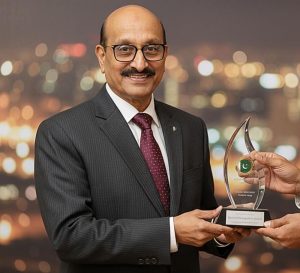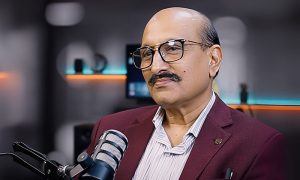Engr. Dr. Muhammad Nawaz Iqbal
By merging nanotechnology with IoT, smart systems are becoming the enhanced benefit of precision, efficiency, and automation. The size of electronics utilizing nanotechnology is immensely tiny, thus energy consumption is lessened during their operation, along with being capable of molecular-level tasks. In this situation, ultra-sensitive sensors, advanced data-processing units, and self-sustaining systems to perform in practically any environment are being developed. One marked contribution of nanotechnology to the field of IoT is the miniaturization of sensors. Nanosensors can detect environmental changes, chemical compositions, or biological markers with extreme precision and sensitivity. When these sensors are embedded into IoT networks, they enhance real-time monitoring in sectors like healthcare, industrial automation, and environmental monitoring, thus making these systems more responsive and adaptable.
Another component of convergence management in nanotechnology and IoT within smart systems is energy efficiency. Traditional IoT devices draw much power for data processing and communication, but nanotechnology has made it possible to develop energy harvesting systems. Nano-enabled batteries, super capacitors, and devices for energy scavenging can derive energy from various ambient sources like vibration, temperature, and light, thus limiting the need for external energy sources. Security remains a significant challenge in IoT ecosystems, while innovative solutions are availed by nanotechnology. Nano-based cryptographic systems, quantum dots, and nanoscale encryption approaches can improve data protection at hardware level against threats in smart systems that are particularly vulnerable like vehicles, smart grids, and medical devices.
The convergence of nanotechnology and IoTs is responsible for smart medical systems that provide real-time diagnostics and drug delivery. Embedded nanosensors in self-worn devices or even implanted in the human body have an important role in monitoring vital signs, detecting diseases at an early stage, and reporting findings to the health systems. Thus, personalized medicine comes along, as well as proactive-oriented healthcare interventions.
Apart from this, industrial automation has also been changed by the convergence. Nanotechnology adds durable and efficient machinery thus ensuring the wear and tear was minimized at the nanoscale, which in-turn enhances the IoT functionalities. Quite some things such as self-healing materials, nano-coatings, and intelligent lubrication systems will provide the best performance of machinery while decreasing direct maintenance costs and machinery downtimes. IoT connectivity, however, ensures that such an intelligent prediction of possible failure of drying any industrial system occurs before it takes place, thus optimizing operational efficiency. Nano-IoT in metropolitan areas would rather invent the next-gen city of tomorrow with sustainable urban management. Nano-enhanced sensors in transportation systems could measure the quality of air, traffic patterns, and the health of buildings. These sensors will feed data for real-time interpretation by city planners who can manage resources more efficiently, ensure optimum public safety, and minimize environmental impacts.
Agriculture is another sector where the convergence of nanotechnology with IoT is introducing smart systems highly optimized for productivity. Nano-enabled soil sensors give very precise readings of nutrient levels and soil moisture, while the IoT connectivity enables farmers to apply data in making critical agricultural management decisions like irrigation, fertilization, and pest management. This, in turn, ensures better crop yield, minimizes wastage in resource use, and promotes sustainable agriculture.
Environmental monitoring has also been a major beneficiary of nanoscale devices that are integrated into IoT networks. Nano sensors detect pollutants at extremely low concentrations to allow authorities to monitor air and water quality in real time. The integration of sensors within IoT platforms allows for a smooth collection of extensive environmental data, enabling quick response action toward ecological threats. Major advancements with nanotechnology-based IoT systems are being made in the transportation sector. Nano-engineered materials in vehicles enhance fuel consumption and structural integrity, while intelligent IoT sensors track vehicle performance and road conditions. This union strengthens traffic management, lowers fuel consumption, and enhances transportation safety.
Consumer electronics are witnessing the advancement of nanotechnology toward the fabrication of ultra-thin, flexible, and powerful devices. Nano-enhanced IoT wearables promise enhanced performance with respect to battery life and connectivity. From nanoscale transistors to quantum dot displays, nanoscale application gives the best user experience to smart phones, smart watches, and augmented reality. Nanotechnology-enabled IoT solutions make supply chain management more transparent and efficient. Nano and smart packaging permit real-time tracking of products and authenticate, preventing counterfeiting. This further helps improve inventory management, mitigate losses, and build better trust between businesses and consumers.
Nanos and IoTs conjugate from space exploration and aerospace engineering to develop ultra light, super-performative materials for satellites and spacecraft. Their nano-coatings help to shield the equipment against radiation and extreme temperatures, and the IoT connectivity provides real-time telecommunication and tele-diagnosis, ascertaining mission success and prolonging the operational life span. Nanotechnology is revolutionizing autonomous systems such as drones and robotics by enhancing the efficiency and performance of monitoring and energy consumption. Nano-powered actuators and nanoscale AI chips will allow machine learning to become more effective in autonomously maneuvering machines in a highly precise and adaptable manner. All of these developments will eventually transform fields like rescuing people from natural disasters, tracking goods from point A to B, and surveillance.
As nanotechnology and IoT converge, building frameworks for regulation, ethics, and interoperability become essential. Proper integration will make these smart systems safe and sustainable, thus unlocking their full potential. Industries will be able to maximize benefits from this technology mix and build a world that is smarter and more interconnected, while still addressing obstacles such as data privacy, energy consumption, and scalability.






